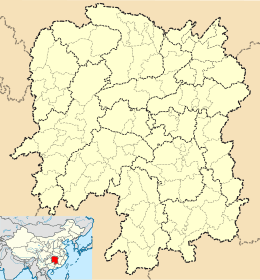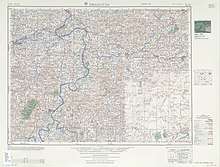Xiangtan
Xiangtan (Chinese: 湘潭; pinyin: Xiāngtán; Wade–Giles: Hsiang-tan) is a prefecture-level city in the central part of Hunan province, China. The hometowns of several founding leaders of the Chinese Communist Party, including Chairman Mao Zedong, President Liu Shaoqi, and Marshal Peng Dehuai, are in Xiangtan's administration, as well as the hometowns of Qing dynasty painter Qi Baishi, scholar-general Zeng Guofan, and tennis player Peng Shuai.
Xiangtan 湘潭市 Siangtan | |
|---|---|
 Jinyuan Square (2010 photo) | |
 Xiangtan Location of the city centre in Hunan | |
| Coordinates (Xiangtan municipal government): 27°49′53″N 112°56′43″E | |
| Country | People's Republic of China |
| Province | Hunan |
| Municipal seat | Yuetang District |
| Government | |
| • Mayor | Zhang Yingchun (张迎春) |
| • Party Secretary | Cao Jiongfang (曹炯芳) |
| Area | |
| • Prefecture-level city | 5,006 km2 (1,933 sq mi) |
| • Urban (2017)[1] | 169.02 km2 (65.26 sq mi) |
| • Districts[1] | 657.7 km2 (253.9 sq mi) |
| Population (2010 census) | |
| • Prefecture-level city | 2,752,171 |
| • Density | 550/km2 (1,400/sq mi) |
| • Urban (2017)[1] | 817,600 |
| • Urban density | 4,800/km2 (13,000/sq mi) |
| • Districts[1] | 915,000 |
| Time zone | UTC+8 (China Standard) |
| ISO 3166 code | CN-HN-03 |
| Website | www |
Geography
Xiangtan is located on the lower reaches of the Xiang River.
Etymology
The name "Xiangtan" is derived from local geography, though there are several explanations for its origin vary somewhat in details. In any case, "Xiang" (湘) refers to the Xiang River, while "Tan" (潭) is a Chinese term that means "deep pool", specifically one produced by a moving current or waterfall; "Tan" in rivers generally are places where the current eddies. One reasoning is that the city was built by a large eddy in a bend of the Xiang River, and was thus called "Xiang-Tan". Another more likely story says the name originated in the Xiangzhou Eddy, today called the Zhao Eddy (昭潭). The Zhao Eddy is an ancient whirlpool located in a deep section of the Xiang River near the traditional border between Xiangtan and Changsha, and is named for King Zhao of Zhou, who is said to have died there.
History
Pre-Ming Dynasty
Relics from the Daxi culture indicate that people inhabited the Xiangtan area in the 3rd millennium BC. Shang Dynasty bronzewares have been found in the region, as well as tombs from the Warring States period. During the Three Kingdoms Period, the kingdom of Eastern Wu built a city in the west of modern Xiangtan City and organized the Hengyang Commandery (衡陽郡) around it. In 749, the Tang Dynasty organized the area as Xiangtan County, centered at modern Yisu River (易俗河). By the time of the Northern Song Dynasty, Xiangtan's good access to both land and water trade routes had established it as the major commercial center of the region.
Ming and Qing Dynasties
Xiangtan prospered throughout the Ming Dynasty and Qing Dynasty upon an economic foundation of trading in rice and traditional Chinese medicinal ingredients, and was sometimes referred to as "Little Nanjing" or "Golden Xiangtan". Prior to the Second Opium War, Xiangtan was a central transfer point for import and export goods going to and from ports in Canton, Shanghai, and Wuhan, supported by approximately 200,000 inhabitants.
Population
As of 2010, Xiangtan had 2,748,552 inhabitants, of whom 1,877,919 lived in the built-up area (2 urban districts plus Xiangtan county). Together with the four adjoining urban districts of Zhuzhou, its built-up area is home to 2,933,069 inhabitants. In 2007, the city was named China's top ten livable cities by Chinese Cities Brand Value Report, which was released at the 2007 Beijing Summit of China Cities Forum.[2]
Geography and climate

Xiangtan has a humid subtropical climate with long, hot summers, and cool to cold, cloudy, damp winters with occasional snow flurries. Within its administrative area, the annual mean temperature is 17.4 °C (63.3 °F), with the coolest month being January, which averages 5.1 °C (41.2 °F), and the hottest July, at 29.1 °C (84.4 °F).
| Climate data for Xiangtan (1981−2010) | |||||||||||||
|---|---|---|---|---|---|---|---|---|---|---|---|---|---|
| Month | Jan | Feb | Mar | Apr | May | Jun | Jul | Aug | Sep | Oct | Nov | Dec | Year |
| Record high °C (°F) | 23.5 (74.3) |
30.1 (86.2) |
32.4 (90.3) |
35.4 (95.7) |
36.0 (96.8) |
37.5 (99.5) |
39.6 (103.3) |
41.8 (107.2) |
37.9 (100.2) |
34.2 (93.6) |
32.7 (90.9) |
24.5 (76.1) |
41.8 (107.2) |
| Average high °C (°F) | 8.5 (47.3) |
10.9 (51.6) |
15.1 (59.2) |
21.8 (71.2) |
26.8 (80.2) |
29.8 (85.6) |
33.6 (92.5) |
32.8 (91.0) |
28.5 (83.3) |
23.2 (73.8) |
17.6 (63.7) |
11.7 (53.1) |
21.7 (71.0) |
| Daily mean °C (°F) | 5.1 (41.2) |
7.3 (45.1) |
11.2 (52.2) |
17.5 (63.5) |
22.3 (72.1) |
25.7 (78.3) |
29.1 (84.4) |
28.2 (82.8) |
23.9 (75.0) |
18.6 (65.5) |
13.0 (55.4) |
7.3 (45.1) |
17.4 (63.4) |
| Average low °C (°F) | 2.5 (36.5) |
4.7 (40.5) |
8.3 (46.9) |
14.2 (57.6) |
18.9 (66.0) |
22.6 (72.7) |
25.5 (77.9) |
24.9 (76.8) |
20.7 (69.3) |
15.3 (59.5) |
9.6 (49.3) |
4.1 (39.4) |
14.3 (57.7) |
| Record low °C (°F) | −6.2 (20.8) |
−8.0 (17.6) |
−1.6 (29.1) |
2.4 (36.3) |
9.6 (49.3) |
13.2 (55.8) |
19.3 (66.7) |
17.1 (62.8) |
12.1 (53.8) |
2.0 (35.6) |
−1.4 (29.5) |
−12.1 (10.2) |
−12.1 (10.2) |
| Average precipitation mm (inches) | 70.9 (2.79) |
97.5 (3.84) |
131.3 (5.17) |
170.1 (6.70) |
184.6 (7.27) |
213.9 (8.42) |
131.6 (5.18) |
106.0 (4.17) |
68.9 (2.71) |
80.5 (3.17) |
73.6 (2.90) |
48.1 (1.89) |
1,377 (54.21) |
| Average relative humidity (%) | 82 | 82 | 83 | 82 | 81 | 84 | 77 | 80 | 81 | 79 | 77 | 77 | 80 |
| Source: China Meteorological Data Service Center[3] | |||||||||||||
Administrative divisions
The city of Xiangtan has direct jurisdiction over two districts (区; qū), two county-level cities (市; shì), and one county (县; xiàn) :
- Yuetang District (岳塘区)
- Yuhu District (雨湖区)
- Shaoshan City (韶山市)
- Xiangxiang City (湘乡市)
- Xiangtan County (湘潭县)
| Map | ||||
|---|---|---|---|---|
| Name | Simplified Chinese | Hanyu Pingyi | Population (2010) | Area (km2) |
| City Proper | ||||
| Yuetang District | 岳塘区 | Yuètáng Qū | 501,348 | 206.4 |
| Yuhu District | 雨湖区 | Yǔhú Qū | 457,955 | 451.39 |
| Suburban | ||||
| Shaoshan City | 韶山市 | Sháoshān Shì | 86,036 | 247.3 |
| Xiangxiang City | 湘乡市 | Xiāngxiāng Shì | 787,216 | 1,912.7 |
| Rural | ||||
| Xiangtan County | 湘潭县 | Xiāngtán Xiàn | 915,997 | 2,132.8 |
Economy
In 2006, Xiangtan's nominal GDP was ¥42.2 billion (US$6.2 billion), a year-on-year growth of 13.2% from the previous year. Its per capita GDP was ¥15,455 (US$2,265).
Xiangtan is famous for its production of Lotus seed and Soy sauce. People in Xiangtan like to chew areca nut (槟榔; bīngláng), though the area itself doesn't grow them. Most raw areca nut fruits are from Hainan and processed locally. The history of consuming areca nut dates back to 400 years ago, when people chewed it for pandemic prevention. Nowadays, it is quite common to see people chewing areca nut in Hunan.[4] In 2003, the sales revenue of areca nut industry in Xiangtan had reached ¥800 million.
Government
The current CPC Party Secretary of Xiangtan is Cao Jiongfang and the current Mayor is Zhang Yingchun.[5][6]
Transportation
Xiangtan is well connected by roads, river and rail. There is a shuttle bus service connecting to Changsha Huanghua International Airport.
Tourism
Many people continue to visit Shaoshan, Xiangtan to visit the birthplace of Mao Zedong, the former Chairman of the Communist Party of China and the paramount leader of the People's Republic of China from 1949–1976.
Some local people like to visit zhaoshan, a small mountain surrounded by trees in Xiangtan.
Sports
Professional tennis player Peng Shuai was born and trained in Xiangtan.[7] Xiangtan Stadium was the home to Bayi Football Team of the Chinese Football Association Jia League (now Chinese Super League) from 2002 to 2003.
Colleges and universities
This is a list of institutions with full-time bachelor programs in Xiangtan:
- Xiangtan University (湘潭大学)
- Hunan University of Science and Technology (湖南科技大学)
- Hunan Institute of Engineering (湖南工程学院)
Notable locals
Xiangtan is the birthplace of:
Notes
- Ministry of Housing and Urban-Rural Development, ed. (2019). China Urban Construction Statistical Yearbook 2017. Beijing: China Statistics Press. p. 68. Retrieved 11 January 2020.
- "China's Top 10 Most Livable Cities". hnloudi.gov.cn. Hunan Loudi Official Government. 2012-03-28. Archived from the original on 2013-04-10. Retrieved 2014-08-04.
- 中国地面气候标准值月值(1981-2010) (in Chinese). China Meteorological Data Service Center. Retrieved 20 October 2018.
- "Despite Risks, an Addictive Treat Fuels a Chinese City" Archived 2017-03-14 at the Wayback Machine article by Dan Levin in The New York Times August 19, 2010, accessed August 20, 2010
- 重磅!张迎春提名湘潭史上首位女市长. Sohu (in Chinese). 2019-02-22.
- Peng Ting; Cao Yang (2019-03-27). 刚刚,张迎春当选湘潭市人民政府市长. hunan.voc.com.cn (in Chinese).
- Agranum, Ritz (2016-07-03). "Tennis News: Peng Shuai of China Struggling to get in top Shape Ahead of Rio Olympics". Chinatopix. Retrieved 2017-01-16.
External links
| Wikimedia Commons has media related to Xiangtan. |
